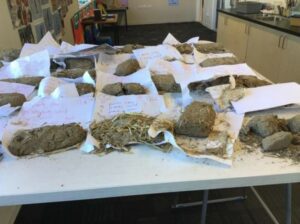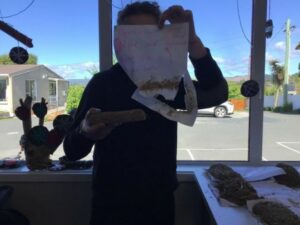Ecological Building Hui lays foundations for student-led small projects

Reimagining built spaces at the hui.
Teachers immediately saw connections between their curriculum and what was experienced at this hui – a combination of unpacking and using the Enviroschools Ecological Building Theme Area and the art and science of combining clay, sand, straw and water to build robust structures at the Ōtepoti Ecological Building hui.
“[I’d] like to do the testing of brick ratios with our students with our resources [locally sourced clay] – [it would] be great aspect for science,” and “Bring ideas into technology, building classes, including NCEA,” were a couple of the comments from participating teachers.
Many participants of the workshop indicated their intention to continue with their Ecological Building planning and PLD in the future. A few of schools had been thinking of an ecological build prior to the hui and used it to further investigate existing ideas and design their build. These projects include a Wattle & Daub inspired wind break at Pūrākaunui school to protect the butterfly habitat they are making next year, an adobe brick and thatch rooved hut at Warrington School where the focus is on locally sourcing clay, and ongoing development of an outdoor classroom at Waitati School. All three schools want support from their facilitator throughout the planning and building process, and connection with possible funding and expert support. One extended primary school thoughtfully brought year 7 students along so these students can lead the project into the following year.

The eco-hut model constructed at the Ecological Building hui in September 2023.
Sustainable Carpenter for Cook Brothers Construction, Daniel Roberts, was keen to be a part of future projects by providing schools with both building materials diverted from landfill and building expertise. Daniel was excited to hear teachers talking about possible ways they could re-use the materials of torn down school buildings to create something on school grounds.
October 2023:
The month after the hui I was invited to Warrington School to support them in deepening their eco hut ideas. Their cob & thatch model sat proudly in their classroom as a tangible connection between what they had learnt at the hui and the possibilities of the future. I am no expert on earth building so I relied heavily on the Enviroschools Ecological Building Theme Area resource to guide us. We spent time moving around the school grounds observing and engaging with the buildings through the “Sketch fast – draw slow” activity. We talked about the materials used in these current buildings and explored more environmentally gentle alternatives. We explored images of earth buildings from the Ecological Building theme area and students reimagined their model through slow, considered drawing.
A plan was hatched for the cob & thatch model to be made into a life-sized building. This required the students to submit a proposal to the school board by the end of the year! So, we continued our investigations into natural building. Students practised ratio testing for adobe bricks and learnt the properties of each material.

Trialling different mixes with interesting results.

The recipe that worked!
Students researched potential sites at the school, considering the environmental and social impacts of building on each site. These evaluations revealed that the project would mean disruption and destruction of the lives and homes of insects and possibly birds who already live in the area. They also realised that insects and animals not directly at the site might be affected by dirty run off into the local stream. These preliminary observations are bringing to light the inter-connectedness of the lives and dwellings of all creatures.
November 2023:
“I visited this morning as the students were putting the final touches on their presentation for the school board next Monday! Wow, they are all really engaged in the process of connecting with the local community and problem solving the realities of making a <10m2 structure from natural materials. “ – Tess MacKay, Enviroschools Facilitator

The original student plan used in the presentation. See banner image for the updated straw bale and clay render version.
Before submitting their proposal, we contacted Nigel Murray of Alexandra (who has significant earth building construction knowledge) for some practical advice. Nigel highlighted challenges in the initial project idea, namely time and labour demands for creating consistent bricks and physical safety considerations for young people lifting heavy adobe bricks at height.
Warrington students have reconsidered their initial concept and embraced the recommended straw bale with clay render technique, where adobe bricks may be used as a feature in a special part of the building. Suggestions made by Nigel Murray and Richard Wilden, a Dunedin Architect, have led the students to decide to build the structural frame of the building from timber. Enter Sustainable Carpenter Daniel Roberts, who is on board to assist with materials in 2024.
The students will present their research with two possible sites to the board. The class has thought of how to make their community a part of the project, they have not only identified local businesses who might be able to support them with materials and equipment, but also how they could honour this contribution and their connection with families and their wider community. They envisage bricks with the names of businesses, families and students to be a part of the building, and to leave a part of themselves through art made with cob inside the building. I’m struck by the importance of the lesson that problem solving and making changes to an original, pure and beautiful idea, does not mean discarding your environmentally gentle intentions.
“In Ecological Building we plan, design and build recognising that we are working in an integrated earth-life system that will eventually take back to itself all the elements of whatever we construct. Our decisions take a long-term and holistic perspective, as we choose materials and processes which will best support the health of the entire ecosystem, now and in the future” – Enviroschool Ecological Building Resource Key Concept, Buildings come from nature and return to nature.”
February 2024 – New Year reflection:

Teacher, Jacqueline Burt, talks to Sustainable carpenter Daniel Roberts on site before the school year begins in 2024.

The planned building site is above the local stream and on the edge of the school community garden.
Since our Ōtepoti yr 7 – 10 Ecological Building Hui in September 2023, Year 7 and 8 students at Warrington School have been refining their eco hut design, finding a site, considering the environmental impact of their hut, practising making adobe bricks and presenting all this mahi to their School Board! Gasp! I do feel daunted at moments by this life-sized project.
When I see the connections the students are making between their own wellbeing – “Eco huts are great places for being calm,” and the environmental benefits of earth building – “lowering our exposure to toxins, conserving water, lowering energy and waste”, I can see that they have already built strong foundations (or in Earth Building speak “Good Feet”) and am filled with excitement to see their “legacy eco hut” take form. -Tess Mackay, Enviroschools Facilitator

Mapping the community garden within which the building will sit.
Blown away by the comprehensive research and zest for the project by the students, the school Board of Trustees said yes to their proposal!
To continue the momentum into the new year, students in Warrington are writing letters to their community inquiring about diggers, clay pits, builders’ sand and straw bales. Students have mapped the community garden area that the eco hut will sit within and have measured out the footprint of the build. Students have identified the small native trees that will be relocated due to the build.
As we stood in the footprint of the future hut, a student raised the issue of transport of materials to the site, asking, “How do we justify burning fossil fuels to bring straw and clay to the school?” Stay tuned for how the students approach this important consequence of a fossil fuel-dependant world.
We are very grateful for the support of Earth Building New Zealand experts who have offered us very practical advice, and pro-bono building plans based on the students’ final proposal. We are also grateful to Cook Brothers Dunedin for their support with materials diverted from landfill. This relationship between Enviroschools, Warrington School and EBANZ will hopefully result in a case study style resource for bringing Earth Building into more schools in Aotearoa me te Wai Pounamu.
Keep an eye out for more exciting ecological building projects around the Otago region as schools from Clutha to Queenstown take part in the Enviroschools Ōtakou Ecological Building Challenge!